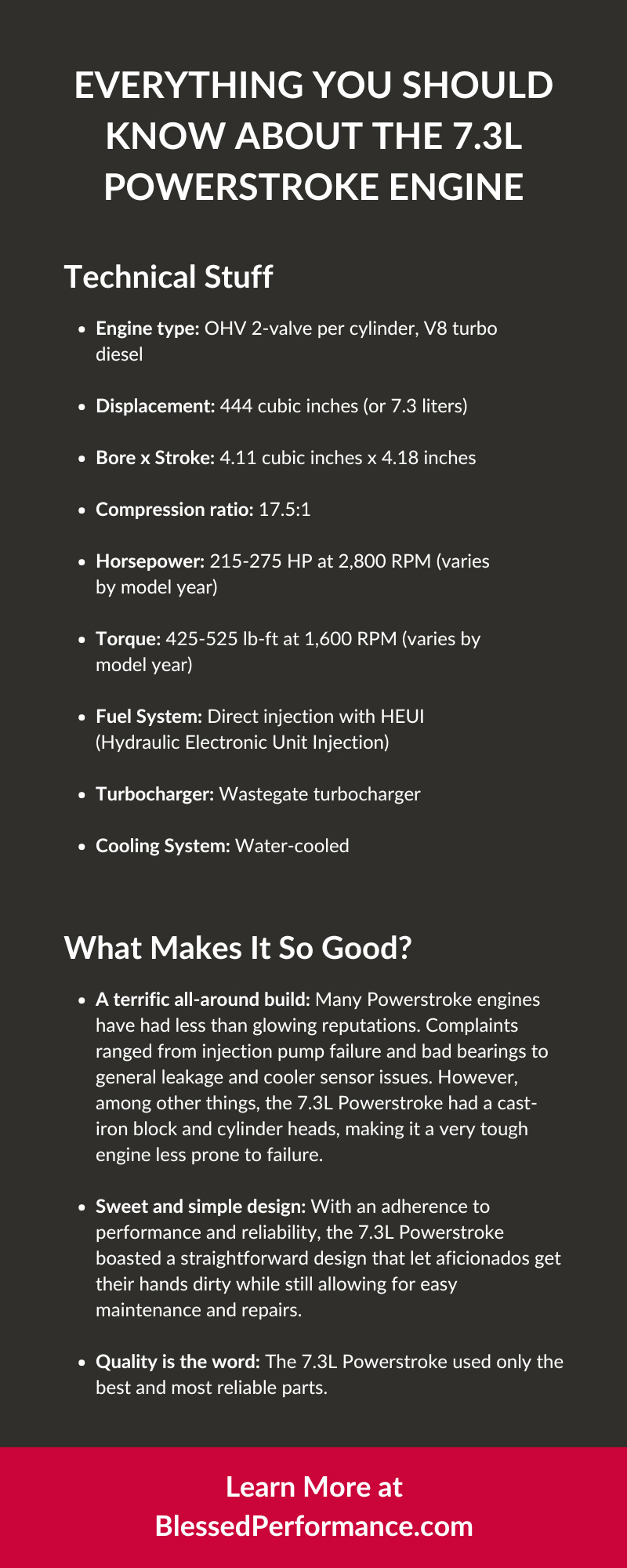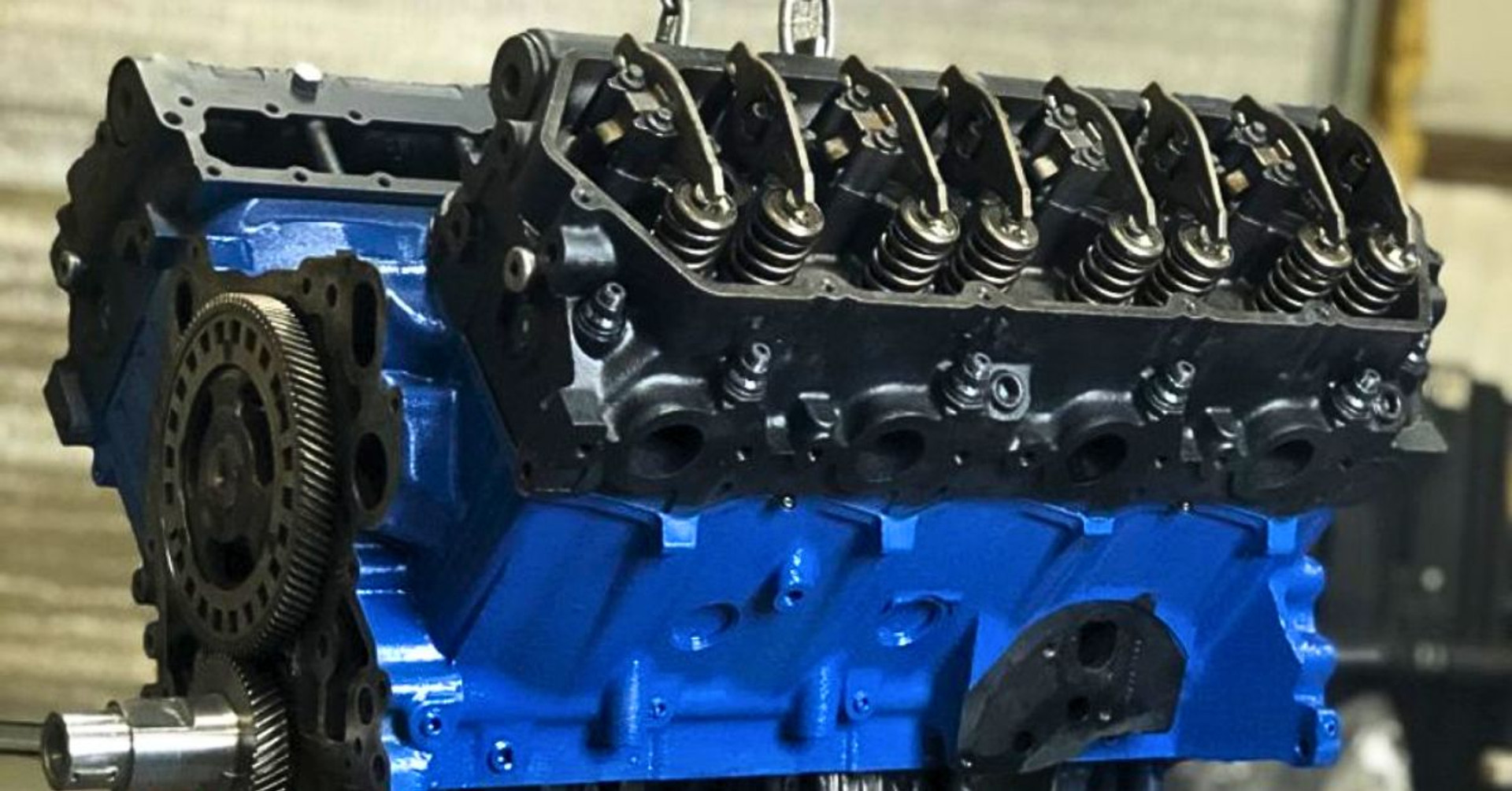Everything You Should Know About the 7.3L Powerstroke Engine
Estimated 0 min read
Whether you’re new to diesel engines or have spent years fixing them up, it pays to familiarize yourself with one particularly famous brand: the 7.3L Powerstroke engine. This legendary engine is one of the largest models available to the average consumer. Delivering powerful performance and durability that couldn’t be beat, the 7.3L Powerstroke has won over more diesel engine fans than any other engine. Peruse our quick guide on everything you should know about the 7.3L Powerstroke engine. If you’re thinking about buying a new truck equipped with one of these or pondering installing a crate engine version inato your current ride, keep the following facts in mind.
Wish Upon a Navistar
Like all Powerstroke engines, the 7.3L was the product of Ford and Navistar as part of their famed Powerstroke line. Ford introduced this engine in 1994 as part of its line of F-series trucks. As mentioned, the 7.3L was a huge hit. Buyers appreciated the engine’s great performance and powerful design. Ford and Navistar produced and installed the 7.3L Powerstroke in Ford’s line of trucks for the next 10 years, but it stayed in truck owners’ hearts for far longer. To this day, enthusiasts still seek out the engine, appreciating its power and performance and wanting to experience both on the road themselves.
[Image A]
Technical Stuff
Getting down to the nitty-gritty, what makes the 7.3L Powerstroke engine so appealing? For the gearheads out there—and we are certain there are many—these technical aspects make a world of difference.
- Engine type: OHV 2-valve per cylinder, V8 turbo diesel
- Displacement: 444 cubic inches (or 7.3 liters)
- Bore x Stroke: 4.11 cubic inches x 4.18 inches
- Compression ratio: 17.5:1
- Horsepower: 215-275 HP at 2,800 RPM (varies by model year)
- Torque: 425-525 lb-ft at 1,600 RPM (varies by model year)
- Fuel System: Direct injection with HEUI (Hydraulic Electronic Unit Injection)
- Turbocharger: Wastegate turbocharger
- Cooling System: Water-cooled
What Makes It So Good?
Many remember the 7.3L Powerstroke as a very reliable engine, capable of wringing great performance out of any drive. Delivering high power and tremendous torque is what it did best, so it was a great addition to any working truck. Towing, hauling, and other heavy-duty jobs were nothing to the 7.3L Powerstroke. People also favored it for its great fuel efficiency, as the engine got more miles to the gallon than other models at the time.
The durability comes into play based on previous owners’ glowing reviews. With basic maintenance, most 7.3L Powerstroke diesel engines clocked 50,000 miles or more, with few to no repairs. So, what was the secret? Several factors came together to create a perfect storm of reliability.
- A terrific all-around build: Many Powerstroke engines have had less than glowing reputations. Complaints ranged from injection pump failure and bad bearings to general leakage and cooler sensor issues. However, among other things, the 7.3L Powerstroke had a cast-iron block and cylinder heads, making it a very tough engine less prone to failure.
- Sweet and simple design: With an adherence to performance and reliability, the 7.3L Powerstroke boasted a straightforward design that let aficionados get their hands dirty while still allowing for easy maintenance and repairs.
- Quality is the word: The 7.3L Powerstroke used only the best and most reliable parts.
All told, these and other elements made the 7.3L Powerstroke a winner.
[Image B]
On the Other Hand…
As the old saying goes, “pobody’s nerfect.” The 7.3L Powerstroke was reliable as all get out, but it still had its occasional issues. Even so, at its worst, it still only required the most basic upkeep to keep running. With that in mind, there are a few things owners must watch out for.
- Camshaft Position Sensor (CPS) failure: This issue announces itself through the engine stalling or a case of no start. The only fix, unfortunately, is replacement of the camshaft position sensor with a new one.
- Injector Control Pressure (ICP) sensor failure: You will know this when you experience it. The engine starts hard, and the engine idles in a rough way. It also announces itself through overall poor performance. Again, the best solution is to replace the ICP sensor, which shouldn’t be too hefty a price.
- Oil leaks: In due time any engine will develop leaks without proper surveillance and maintenance. Stay on top of leaks before they develop or get bad, watching for visible stains and excessive oil consumption. Replacing a head gasket will likely be costly.
- Glow plug failure: Here is a familiar and famous issue with many Powerstroke engines. When it’s hard to start up the truck in the bleak cold days of winter, check your glow plugs.
- Clogged fuel filter: Another common problem with some diesel engines. A clogged fuel filter will clearly interfere with starting and general performance. This is an avoidable issue, fortunately. Make a habit of replacing the fuel filter to prevent clogging from occurring.
As always, the best way to keep a 7.3L Powerstroke (or, indeed, any engine) chugging along is periodic maintenance. Stay on top of your oil changes and use high-quality oil. As mentioned, it’s best to replace the fuel filter and air filter every 15,000 miles. Every 30,000 miles, check with your mechanic to see if it’s time to flush the cooling system. Keep all the fluids topped off and clean, especially the transmission and its filter. Watch your belts too—if they look loose, worn, or ready to fray, replace them. By and large, establish a regular maintenance schedule with your mechanic and stick to it.
Keeping Your Engine Happy
That is everything you should know about the 7.3L Powerstroke engine (though there’s always more to learn). This engine’s fame is well-earned, and to this day, it remains a powerful player in the automotive world. If you’re considering purchasing a 7.3 Powerstroke crate motor or a vehicle with an old or restored one, feel free to contact us for a consultation about your truck’s performance enhancement options. We offer affordable parts and more to keep your engine running and happy!










